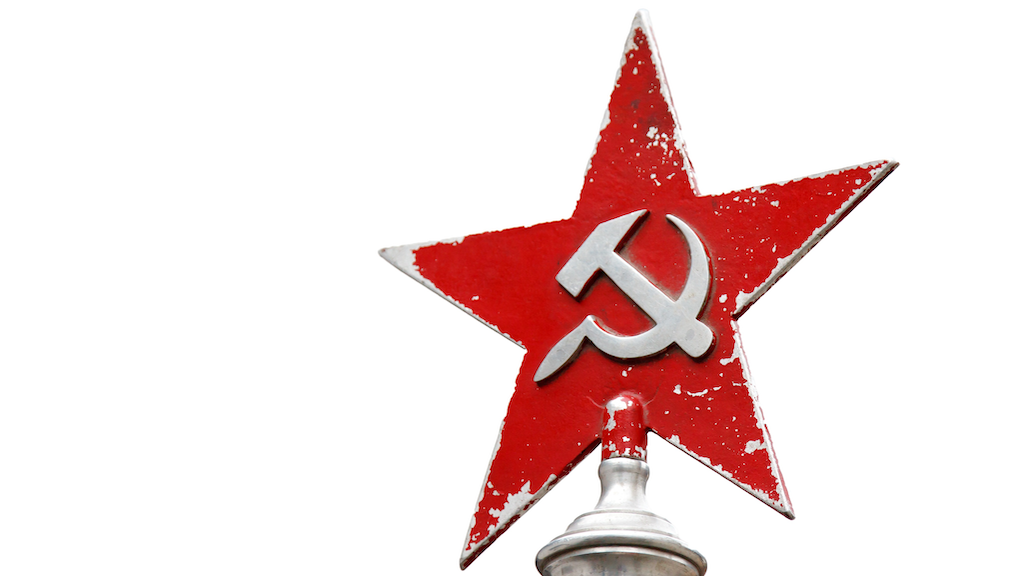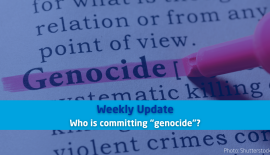Red Terror: How the Soviet Shaped Modern Anti-Zionist Discourse
The Arab-Israeli conflict traverses many decades and manifests in regular wars, terrorism and endless political skirmishes on international forums. It is also a battle to establish narratives – victims and aggressors, Davids and Goliaths, oppressors and the oppressed. Language and the meaning given to basic concepts form a key part of the battle. Jewish people can justly establish a claim to the territory known as Judea and Samaria. While the later formulation ‘West Bank,’ coined by the Jordanians following their occupation of the area in 1948 is a bland geographic descriptor that strips the territory of its historical significance. The Associated Press recently stumbled into the morass of political language when it declined to identify the men who tortured and killed Israeli athletes at the Munich Olympic Games in 1972 as Palestinian terrorists, instead calling them ‘guerillas’ and ‘gunmen.’ And there is no term in the vernacular of the conflict that is misapplied and distorted more than ‘Zionism.’
Zionism, correctly understood, refers simply to the return of Jewish people to ‘Zion,’ one of several names given to Jerusalem and the surrounding lands in which the Jews lived and governed in ancient times. In the late 19th century, the idea of returning to those lands shifted from a seemingly intangible ideal and a wistful age-old expression of yearning for freedom to a precise, secular, political movement.
Zionism aimed to reconstitute a Jewish state in the territory the Jews knew as ‘Eretz Yisrael’ (The Land of Israel), which had been renamed ‘Palestine’ following the suppression of the final Jewish rebellion by the Roman Emperor Hadrian in the year 135 CE. The Balfour Declaration, United Nations General Assembly Resolution 181 (II), and a succession of binding instruments of international law from the San Remo Resolution to the League of Nations Mandate for Palestine, had all recognised that the Jews were a distinct people with an unbroken connect ion to the land and a right to reform their state in some part of that land.
Zionism, therefore, was the foundational movement of the modern state of Israel. As such, those determined to erase an autonomous Jewish presence from the Middle East have assessed that if they can succeed in depicting Zionism as something loathsome and unjust, the case for Israel can be dramatically undermined.
The contemporary campaign to distort the meaning of Zionism and to associate it with popular concepts of evil largely has its origins in the rapid deterioration of Soviet-Israeli relations, which conditioned attitudes to Israel in the political left.
Zionism was once celebrated by the left as an organic movement of national return and a model for national liberation and decolonisation movements throughout the world.
Israel’s victory in its War of Independence and refusal to succumb to far mightier foes was positively awe-inspiring to adherents of political movements predicated on toppling structures of power. As chronicled by Philip Mendes in his study of Zionism and the political left, “all international communist parties supported partition and the creation of a Jewish State.” The US Communist Party called Israel “an organic part of the world struggle for peace and democracy,” while the French Communists viewed the Jewish fighters as the comrades of resistance fighters throughout the world.
But as Israel charted its own course, emerged from its wars economically and militarily superior to the Arabs, and became more ambitious and assertive in how it conducted its security affairs, the support of the Soviet Union and the international left entered a sharp decline, followed by a complete reversal.
As the Cold War set in, Israel’s first prime minister, David Ben-Gurion, assured the US Ambassador that Israel was “western in its orientation, its people are democratic, and realise that only through the co-operation and support of the US can they become strong and remain free.”
Israel’s ‘western orientation’ became abundantly clear to the Soviet Union when Israel joined Britain and France in the Suez Campaign in 1956 to liberate a key maritime route linking Asia to Europe amidst threats to nationalise the canal by Egypt’s President Gamal Abdel Nasser, a key Soviet ally.
The campaign, seen by Moscow as a direct threat to its strategic power in the Middle East, sent the Soviets into a state of foaming apoplexy, resulting in threats to deploy nuclear weapons against the British and French and to annihilate Israel entirely.
The Soviet Union had already cut diplomatic relations with Israel in February 1953, only weeks before the death of Stalin and after a period of rapid escalation of state anti-Semitism, culminating in the notorious ‘Doctors’ Plot,’ in which Jewish doctors in the Soviet Union were accused of plotting to poison Party officials.
Soon the state media was saturated with anti-Zionist propaganda, depicting bloated, hook-nosed Jewish bankers and all-consuming serpents embossed with the Star of David.
Anti-Zionism had become virtually indistinguishable from anti-Semitism. As the British political theorist, Alan Johnson, observed, “what ‘the Jew’ once was in older anti- Semitism – uniquely malevolent, full of blood lust, all- controlling, the hidden hand, tricksy, always acting in bad faith, the obstacle to a better, purer, more spiritual world, uniquely deserving of punishment, and so on – the Jewish state now is…”
In time, these depictions appeared not only in Soviet publications but were distributed globally through communist parties and publications throughout the world. These ideas would eventually nestle in far-left circles in the West, including political parties, human rights organisations, militant trade unions, and of course, campuses.
The propaganda was highly compelling and steeped in long-established themes of Jewish bloodthirstiness, greed, corruption, manipulation and cunning. It would contend that the very existence of a Jewish homeland was not only a plot of imperialism but a mortal danger to the peace of the world.
It was what Hitler called the ‘big lie’ – the use of dramatically overblown fiction to deceive the public. Hitler, the supreme propagandist, observed that the bigger the lie, the more believable it was: “It would never come into people’s heads to fabricate colossal untruths, and they would not believe that others could have the impudence to distort the truth so infamously…”
The big lies about Zionism would soon find their way into the most influential forums in the world. When a sub- commission of the United Nations was tasked with drafting a convention on the ‘elimination of all forms of racial discrimination,’ the proceedings naturally focused on apartheid, neo-Nazism and anti-Semitism. But the Soviets viewed the reference to anti-Semitism as a direct rebuke to their anti-Jewish measures and served up an amendment that ‘was almost a joke,’ even to the Soviet delegation itself.
The amendment inserted Zionism into the listed forms of racism. According to sources close to the deliberations, the Soviets understood “full well that the idea that Zionism is racism is an indefensible position,” yet they floated it anyway, in part to turn the US-led initiative into farce, and in part perhaps, to see how far a ‘big lie,’ could go.
Ultimately, the Convention was adopted with neither anti-Semitism nor Zionism referred to – the ploy had worked. But the seed had been planted.
On 10 November 1975, the General Assembly of the United Nations passed resolution 3379 on the ‘elimination of all forms of racial discrimination,’ which determined that ‘Zionism is a form of racism and discrimination.’
The US Ambassador to the United Nations Patrick Moynihan called the resolution “a great evil …” that had given “the abomination of anti-Semitism the appearance of international sanction.”
The proposition that the Jewish emancipation movement was actually a form of racism, now declared to be true by the United Nations, could then be used to purge mainstream Jewish voices from liberal campaigns and civil society organisations.
In 1977, student unions across Britain debated motions along the lines of Resolution 3379. York, Salford, Warwick and Lancaster went further, passing motions to expel their Jewish societies “on the grounds that they are Zionist and therefore racist.”
The concept of denying platforms to fascist and white supremacist speakers on university campuses was now being applied to stifle mainstream voices who expressed support for the state of Israel.
Moynihan foresaw this. An earlier UN resolution had, at the instigation of the Soviet Union, viewed “racism to be merely a form of Nazism.” It followed that if racism was merely a form of Nazism and Zionism is a form of racism, then Zionism is a form of Nazism.
On this basis, anti-Zionist students could harass Zionists and be seen as taking a noble stand against Nazism. This twisted logic was applied by anti-Israel students at Sydney University in 2015 when they attempted to stop the public lecture of a retired British colonel for his earlier statements in support of Israel, and by the organisers of the Chicago Dyke March who blocked Jewish participants from marching with Stars of David on the basis that Zionism was a form of ‘white supremacism.’
The theme of Jews becoming the new Nazis, a double blow that associates Zionism with supreme evil and mocks the victims of the Holocaust by equating them with their murderers, has become a mainstay of anti-Zionist discourse.
In a conflict as deep-seated and volatile as this, it may seem a trifling pursuit to seek to restore accurate meaning to terminology. But there can be no hope for peaceful coexistence between Israelis and Palestinians so long as the movement on which Israel was established seven decades ago, the movement that expresses Jewish hopes and Jewish rights, is so poorly understood and so successfully distorted.
Originally published by the Australian Institute of International Affairs. Reproduced with permission.




